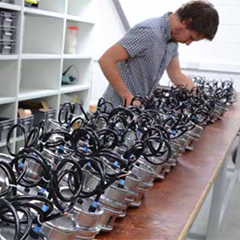We take a closer look at an award-winning innovation that could revolutionise the design of floating turbines.
This year, the UK’s longest running and most prestigious prize for engineering innovation was awarded by the Royal Academy of Engineering to Artemis Intelligent Power. Known for spotting the ‘next big thing’ in the technology sector, the MacRobert Award identifies outstanding innovation with proven commercial success and tangible social benefit.
In particular, the prize recognised Artemis’ use of digitally controlled hydraulics to increase the power output of wind turbines. Their Digital Displacement (DD) transmission, according to the judges of the award, “has the potential to transform the viability of offshore wind power and low carbon transportation”. The technology is currently being used on the world’s largest floating wind turbine.
When the wave energy research group at the University of Edinburgh, led by Professor Stephen Salter first started developing hydraulic systems, however, it faced an uphill struggle. As he wrote at the time: “The reputation that high-pressure oil has in 1984 is very like the reputation that electronics had in 1944. It is used with reluctant suspicion for jobs that cannot be done in any other way. It is thought to be expensive, complicated, temperamental, unreliable and inefficient. It is blamed for everything that goes wrong.”
Despite this, Professor Salter’s research went so well over the next few years that he and his colleague Dr Win Rampen FREng, decided to commercialise it and they set up Artemis Intelligent Power in 1994.
Salter had previously come up with the idea of a very large electronically controlled slow-speed ring-cam pump, while Rampen had realised that similar concepts could be put to use in a high-speed motor such as would be needed to drive a generator. Putting the two together led to an infinitely variable speed hydraulic system, with a pumped fluid carrying energy from place to place rather than a fixed-speed mechanical gearbox.
DD technology replaces the conventional analogue mechanisms that are used to vary the displacement of hydraulic machines with a completely digital control method.
The multiple working chambers of the new machines each have solenoid-operated valves that are controlled by an embedded computer synchronised to the rotation of the shaft. A computer provides real-time control of every working stroke of the machine.



























